Albuca cremnophila
Albuca cremnophila Van Jaarsv. & Van Wyk
Family: Hyacinthaceae
Common names: Baviaanskloof cliff-albuca (Eng.), Baviaanskloof-kransslymstok.
Introduction
Albuca cremnophila is a solitary to cluster-forming, bulbous cliff-hanger with long, narrow pendent leaves that grow to more than 1 m long and white flowers in extended racemes to almost to 2 m long, drooping from the cliff-faces of the Baviaanskloof in the Eastern Cape.
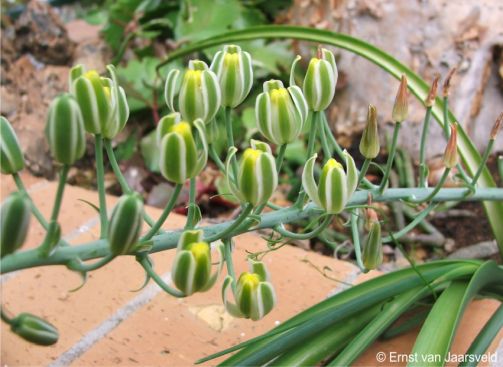
Fig. 1. Albuca cremnophila in full flower in the Botanical Society Conservatory at Kirstenbosch National Botanical Garden in spring.
Description
Description
The bulbs are evergreen, embedded at soil level or just above (epigeous), rarely below soil level (hypogeous). They are solitary at first but divide to form small, dense clusters. The bulb is egg-shaped, 90 × 50–60 mm; the bulb scales (tunics) fleshy, the bulb scale tips blunt (truncate), arranged almost like tiles on a roof (imbricate), and green to greyish-green. The roots are fleshy, white, up to 3 mm in diameter. The leaves 30–70 × 20–30 mm, in a tight, one-sided, apical rosette. The leaves are dark green, firm, oblong, channelled (canaliculate), long and narrow with a tapering base (linear-attenuate), and drooping in its habitat and from containers. The leaves are smooth and become rounded (terete) towards the tip, ending sharply in a point (apex acute), with a whitish median stripe.

Fig. 2. Close-up of a cluster of Albuca cremnophila in the Botanical Society Conservatory at Kirstenbosch National Botanical Garden, showing the one-sided leaf rosettes.
The inflorescence consists of a spreading to pendulous raceme, up to 2 m long. The peduncle up to 250 mm long, the bracts acuminate, membranous and the margin translucent. Basal bracts up to 110 × 13 mm, gradually becoming smaller upwards. The individual flower stalks (pedicels) erect, 35–80 mm long (exceptionally 120 mm), becoming shorter distally (35 mm). The flowers all on one side (secundly arranged), 20–25 mm long, dense, erect, white with a green median stripe; outer tepals linear-obovate, 20–25 × 7–8 mm, white with green median portion, inner tepals 18–20 × 8–10 mm, ovate with hooded yellowish apex. Filaments 13 mm long, 2.5 mm in diameter at base. The female portion (ovary) is shortly stalked (stipitate) for 1 mm, 6 mm long, 4 mm in diameter at base, narrowing to 3 mm, 3-angular, basally each angle with raised twin tubercles; stigma linear-trigonous, 10 ×2 mm. The fruiting capsule 15 × 9 mm. Seed flat, 4 × 3 mm.
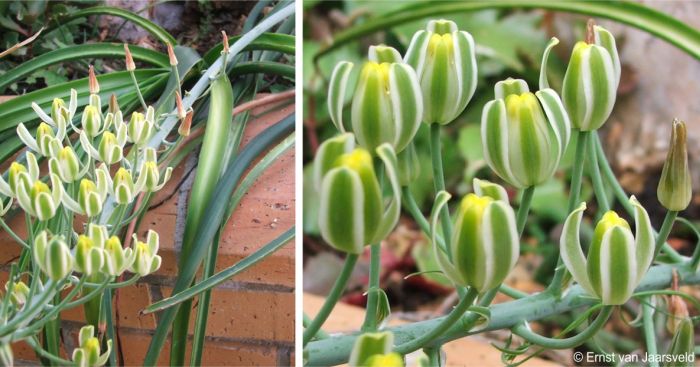
Fig. 3. Albuca cremnophila in full flower in the Botanical Society Conservatory at Kirstenbosch National Botanical Garden, in spring. Note the yellow tipped flowers.
Albuca cremnophila flowers mainly in late spring (October and November). The seeds are normally released in early summer, towards the end of November to early December, and are dispersed by the wind.
Conservation Status
Status
Although Albuca cremnophila is rare, it is not threatened and is thus assessed as Least Concern (LC) by the Red List of South African Plants. The plants are well-established in protected reserves and it is well protected by its inaccessible, stable, cliff habitat that is a refuge for the species and it is not facing any other threats.

Fig. 4. LEFT Gert Smitskloof, Baviaanskloof, habitat of Albuca cremnophila, seen here growing among many succulent species; CENTRE and RIGHT in flower in Gert Smitskloof, note the long, pendent inflorescence and upturned flowers.
Distribution and habitat
Distribution description
Albuca cremnophila is only known from Baviaanskloof and the adjacent Kouga Dam region west of Hankey, in the Eastern Cape. The geology represents mineral-poor quarzitic sandstone of the Peninsula Formation (Cape Supergroup). The rock face has sufficient ledges and crevices for the establishment of plants. Albuca cremnophila grows mostly confined to sheer cliffs along dry river valleys and in dark, narrow kloofs, at all aspects but more often on the cooler, south-facing cliffs. Plants are firmly rooted in crevices at altitudes from 300–600 m, and are scattered and never common. The winters are cool but frost is a rarity or absent. The average daily maximum temperature is about 27°C and the average daily minimum about 9°C. Rainfall is mainly in summer and less so during winter, ranging from 200–300 mm per annum in the form of thunder showers and cyclonic winter rain. The vegetation consists of Gamtoos Thicket of the Albany Thicket Biome. Associated plants on the cliff face include: Aloe mitriformis, Adromischus cristatus var. zeyheri, Crassothonna cacalioides (= Othonna carnosa), Cotyledon tomentosa subsp. tomentosa, Crassula lactea, Cyrtanthus flammosus, Cyrtanthus labiatus, Cyrtanthus montanus, Delosperma esterhusyeniae, Euphorbia heptagona, Gasteria rawlinsonii, Haemanthus albiflos, Haworthia cooperi var. picturata, Haworthiopsis viscosa, Lampranthus affinis, Othonna lobata, Plectranthus verticillatus, Portulacaria afra and Tromotriche baylissii.
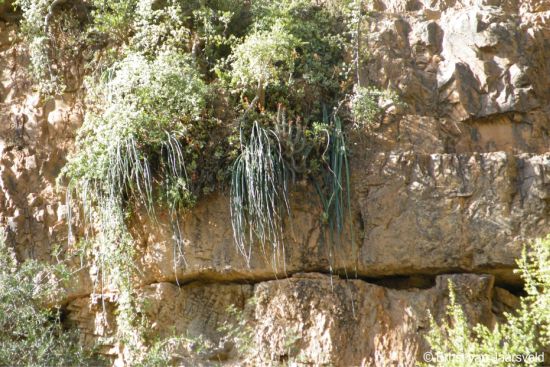
Fig. 5. Albuca cremnophila in habitat on a cliff ledge at Baviaanskloof, growing among Crassula lactea, Euphorbia heptagona, Portulacaria afra, Aloe mitriformis and many other succulent species.
Derivation of name and historical aspects
History
Albuca cremnophila was named by Braam van Wyk and the author in the Aloe magazine in 1999 from plants collected at Gert Smitskloof, Baviaanskloof. The name is derived from the Latin cremno, meaning ‘cliff’, and the Greek phileein, meaning ‘to love’, pertaining to its cliff habitat.
The genus Albuca was established by Carolus Linnaeus in his second edition of Species plantarum in 1762, presently consisting of more than a 100 species. There is a clear centre of diversity in the southern parts of South Africa. The name Albuca, from the Latin albus meaning ‘white’ or albicans, ‘becoming white’ pertains to the white flowers observed in many species.
Albuca cremnophila belongs to the subgenus Albuca created by Muller-Dobblies in 1995, which is immediately recognised by the succulent, hinged inner tepals and ascending flowers. The outer stamens are usually reduced, whilst the inner are larger and fertile. It is related to other cliff-dwelling Albuca species including A. batteniana, A. buffelspoortensis and A. thermarum. These four species all belong in subgenus Albuca, they are evergreen and with pendent leaves. Albuca cremnophila is at once distinguished from them by its long narrow leaves in a tight horizontally-pointing rosette, and densely flowered, pendent inflorescence up to 2 m long. When the inflorescence is hanging vertically, the flowers all point upwards. Albuca batteniana has much broader leaves in a more open rosette and larger flowers. The individual flowers of Albuca cremnophila are greenish-white, yellowish tipped and 20-25 mm long. Of this group, Albuca thermarum is the only one which has flowers which are spirally arranged. In all the others the flowers grow on one side, and all are pointing upwards more or less at the same level, termed secund.
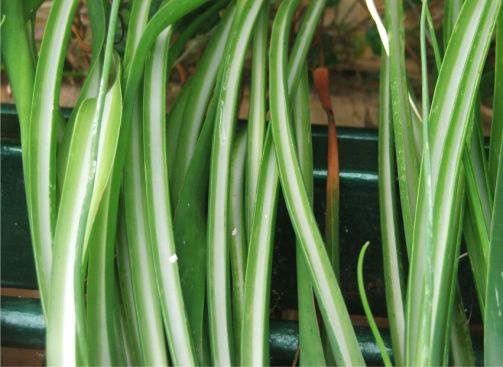
Fig. 6. A solitary plant of Albuca cremnophila in habitat at Gert Smitskloof, Baviaanskloof. Note the pendent inflorescence and upturned flowers.
Ecology
Ecology
Only known from sheer cliffs, the bulbs wedged firmly into crevices. Initially solitary, later dividing to form clumps. The bulb, as with so many cliff-dwelling bulbous species from dry habitats, grows above the soil or rock, sometimes only partially covered by the substrate. Due to its sheer habitat there are few other disturbances in this safe cliff habitat. The upper tunics ensure the leaves are in a tight one-sided rosette, facing away from the cliff. The long-lived, firm leaves soon become pendent, as is as the extended inflorescence. Water runoff is high on cliffs and the plants have to cope with periodic dry conditions. The succulent bulb scales store sufficient amounts of water to enable the plants to cope. The cliff is out of reach of the large herbivores and thus is a safe refuge for the plant. The white median stripe on the upper leaf surface acts as a window allowing light to penetrate for photosynthesis.
Flowers are pollinated by insects and the capsules are presented in a ascending position, an adaptation allowing the seed to become airborne with sufficient wind velocity. The flattish 3 × 4 mm seeds are dispersed by wind and when landing on a suitable ledge, will root, becoming established.
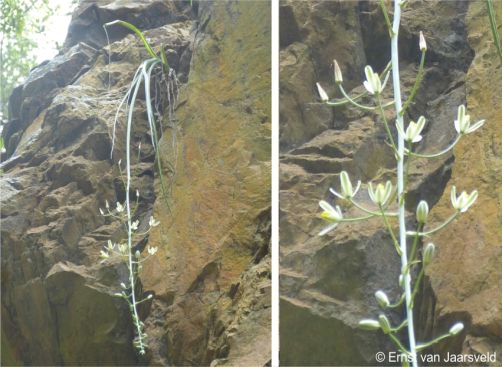
Fig. 7. Close-up of the channelled leaves of Albuca cremnophila showing the broad white midstripe, which functions as a window allowing light to penetrate to the inner leaf tissue.
Growing Albuca cremnophila
Grow
Albuca cremnophila can be cultivated in gardens, or containers. There are examples growing in pots on the balcony of the Botanical Society Conservatory at Kirstenbosch National Botanical Garden and in the Babylonstoren Farm succulent house. It is best grown in thicket and dry bushveld gardens on south facing (southern hemisphere) steep embankments such as gabions. When grown away from its environment it is better in a greenhouse under controlled conditions. Ensure that the soil is well-drained.
Best planted about 30 cm apart and established during spring. Use containers at least in a 20 cm diameter. The soil should be sandy and consist of 2 parts sand or gravel, 1 part loam and 1 part well broken down compost. On a balcony, place in a region where the plants get dappled shade, and allow space for the leaves and inflorescence to become pendent.
Albuca cremnophila can be propagated from seed or division. Most Albuca taxa are easily grown from seed sown in a sandy mixture, placed in a warm protected environment. Germination is usually within 3 weeks and the young seedlings are transplanted to individual containers when they are large enough to be handled.
References
- Clarke, H. & Charters, M. 2016. The illustrated dictionary of southern African plant names. Flora & Fauna Publications Trust, Jacana, Johannesburg.
- Linnaeus, C. 1762. Species plantarum edn. 2, vol. 1. Salvius, Stokholm.
- Mucina, L. & Rutherford, M.C. (eds) 2006. The vegetation of South Africa, Lesotho and Swaziland. Strelitzia 19. South African National Biodiversity Institute, Pretoria.
- Manning, J.C., Forest, F., Devey, D.S., Fay, M.F. & Goldblatt, P. 2009. A molecular phylogeny and a revised classification of Ornithogaloideae (Hyacinthaceae) based on an analysis of four plastid DNA regions. TAXON 58(1):1-107.
- Müller-Doblies, U. 1995. Enumiratio Albucarum (Hyacinthaceae) Austro-Africanarum adhuc congniatarum. Feddes Repertorium, 106: 353–370.
- Raimondo, D., Von Staden, L., Foden, W., Victor, J.E., Helme, N.A., Turner, R.C., Kamundi, D.A. & Manyama, P.A. (eds) 2009. Red list of South African plants. Strelitzia 25. South African National Biodiversity Institute, Pretoria.
- Van Jaarsveld, E.J. & Van Wyk, A.E. 1999. Five new cremnophilous taxa from semi-arid regions in South Africa. Aloe 36 (4): 71–74).
- Van Jaarsveld, E.J. 2013. Albuca deaconii (Hyacinthaceae), a new bulbous species from the Eastern Cape. Herbertia 66: 146–154.
- Van Jaarsveld, E.J., Van Wyk, A.E. & Blake, T. 2007. Ornithogalum cremnophilum. Flowering Plants of Africa 60:8–13.
Credits
Ernst van Jaarsveld
Kirstenbosch National Botanical Garden (Retired)
Babylonstoren Farm (Current)
Extraordinary senior lecturer and researcher,
Department of Biodiversity and Conservation, University of the Western Cape
May 2025
Plant Attributes:
Plant Type: Bulb
SA Distribution: Eastern Cape
Soil type: Sandy
Flowering season: Spring, Early Summer
PH: Acid, Neutral
Flower colour: Green, White, Yellow
Aspect: Full Sun, Morning Sun (Semi Shade)
Gardening skill: Easy
Special Features:
Horticultural zones
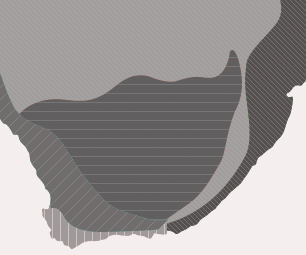







Rate this article
Article well written and informative
Rate this plant
Is this an interesting plant?
Login to add your Comment
Back to topNot registered yet? Click here to register.